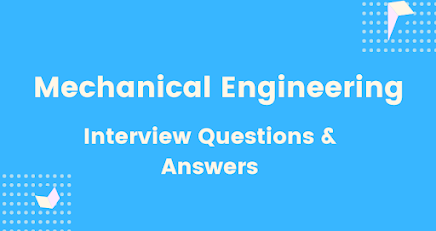50+ Mechanical Engineering Interview Questions with Answer
1) What is the second law of thermodynamics?
The second law of thermodynamic depicts that the total entropy of an isolated system can never
reduce over time.
2) What is ferrite?
Ferrite is a magnetic iron rock.
3) Which pipes are used for steam lines?
Steel pipes with welded fitting are used for steam lines.
4) Distinguish between the shear center and elastic center.
The shear center is a center where the force can act with no twist, whereas elastic center is located at centre of gravity.
5) Name two vital conditions of a perfect gas.
Two vital conditions of perfect gas are:
It should satisfy the state equation.
Specific heat remains constant.
6) What is mean by greenfield project?
These are the projects, which are built from scratch and does not create pollution.
7) What do you mean by cotter joint?
It is one of the types of a joint that are used to connect two rods, which are under compressive or tensile stress. This joint is made of steel or iron. Cotter joint is used for connecting a piston rod to the crosshead of the reciprocating steam engine.
8) Define pitting.
It is corrosion that turns to a small hole in the metal.
9) What is the alloy of tin and lead?
Solder is an alloy of tin and lead. It is primarily used to make electrical joints.
10) What is the importance of tolerance in engineering?
You cannot design any product without tolerance. It increases the chances of rejection rate and overall product cost. You utilize tolerance in part dimension to reduce cost and facilitate manufacturer.
11) What is caustic embrittlement?
Caustic embrittlement is a physical change in metal. In this phenomenon, the boiler becomes brittle because of accumulation of caustic soda.
12) Name the boiler that does not need a steam drum.
Supercritical pressure boiler does not need a steam drum.
13) Explain the Otto cycle in brief.
Otto cycle describes the functioning of a typical spark-ignition four-stroke engine. Otto cycle is a description of what happens to gas as it is subjected to changes of volume, temperature, addition, or removal of heat.
14) What do you mean by annealing?
Annealing is the process of heating any material above the recrystallization temperature and cooling after some time. This process increases the hardness and strength of metal material. The result you will get is a reduction of dislocations in the crystal structure of metal being annealed.
15) Explain enthalpy.
It is the heat content of a thermodynamic system.
16) Define a uniformly distributed load.
A uniformly distributed load is a load which is spread over a region of the beam. Here the magnitude of the load remains similar throughout the element.
17) Explain different types of fits.
Fits can be categorized into three groups: 1) clearance fit, 2) interference fit, and 3) transition fit.
Clearance fit: This fit is identified by the occurrence of clearance between the two similar parts.
Interference fit: In this fit, the size of the mating parts is predefined to occur interference between these parts. Here the hole tolerance zone is completely below shaft tolerance zone.
Transition fit: It is a comptonization between clearance and interface fit. In this case of fit, the tolerance zone of the shaft and hole overlaps.
18) Explain important rules that must be kept in mind while designing castings?
Keep section thickness uniform as much as possible.
Sudden changes in the thickness should be averted at all costs.
Design casting by keeping simplicity.
Avoid large flat surfaces as true large spaces are difficult to create.
Use a curved shape to improve the stress handling of the cast.
19) What is universal coupling?
Universal coupling is used to connect two shafts whose axes are inclined to each other. It consists of a pair of hinges, connected by a cross shaft.
20) Why would you use pneumatics?
Pneumatic systems are significantly cheaper than other streams, i.e., hydraulic system. It can move faster and do not leak oil if they develop a leak.
21) Explain mechanical refrigeration.
Mechanical refrigeration is a process by which heat is removed from a specific location using an artificial heat-exchange system. The refrigeration system can be cyclic, non-cyclic, magnetic, or thermoelectric depending on the application for which refrigeration is needed.
22) What are various types of brakes?
Various types of brakes are 1) hydraulic breaks, 2) electric breaks, and 3) mechanical breaks.
23) How will you classify sliding contact?
Sliding contact can be classified based on the various thickness of film bearings.
24) How will you create a piston head?
Piston head can be designed on the bases of the following points:
The crown must have enough strength to absorb the explosion pressure inside the cylinder.
You can consider Grashof’s formula to calculate the thickness of the head.
25) Explain knurling.
It is a manufacturing process conducted on the lathe tool to create a pattern on a bar that can be used a handle.
26) What is the importance of thermostat in the cooling system of an engine?
Thermostat makes sure to keep the engine cool at the optimum level. It prevents decreasing the overall efficiency of the engine.
27) What is the most basic characteristic of supercritical boilers?
Supercritical boilers do not have a heavy drum to separate steam from water and steam. They also require less steel metal.
28) What is the relation between the thickness of the thermal boundary layer and the depth of the hydrodynamic boundary layer?
The ratio of thickness = (Prandtl number)-1/3.
29) What do you understand by engineering drawing?
It is a technical document used to transfer technical details and define requirements.
30) Define the least count?
It is the smallest value that can be measured by measuring instrument. Least count can be measured using the following formula:
Least Count= Value of one scale division - Total number of a Vernier scale division.
31) What are the different types of screws?
Screw Head
Screw Thread Type
Screw Drive Type
32) What is process flow diagram?
A process flow diagram is a sketch which describes major equipment, plant streams, and key central loops show the relationship between system components. This diagram contains symbols to identify instruments and vessels it describes the primary flow course.
33) What is GD&T?
GD&T is a sort abbreviation of Geometric Dimension & Tolerance. It is a system which defines engineering tolerances.
34) Explain bearing?
Bearing is a device that is placed between two components of engine for the smoother movement. It enhances the efficiency of any machine.
35) What is the difference between pipe and a tube?
The significant difference between pipe and a tube is that a pipe can be measured based on its inner diameter. On the other hand, a tube can be measured based on the outer diameter.
36) Explain the term torque?
A force that causes rotation is called torque. It is a measure of how much force is required to rotate an object.
37) What do you mean by emissive power?
It is the amount of radiation emitted per unit.
39) Differentiate between total moisture and inherent moisture of coal.
Total moisture in the coil is referred to as the moisture of the bulk as a sample while the air-dried sample is called inherent moisture.
40) What does AFBC stand for?
AFBC stands for Atmospheric Fluidized Bed Combustion.
41) What are the benefits of cycloidal gears?
It has a wider and high-power flank as compared to Involute gears.
The contact of Cycloidal gears is between the concave surface and the convex flank. This will reduce the wear and tear of the engine.
There are no chances of occurring any interference in Cycloidal gears.
42) Briefly explain the term Gravity?
Specific Gravity is the proportion of the mass of a substance to the density of a reference substance.
43) Why is cast iron seasoning important before machining?
Cast iron seasoning is important for easy machining and saving the cutting edge of the tool.
44) What do you understand by heat treatment?
It is an operation that involves heating and cooling process of metals to change its properties.
45) How can you identify mild steel, cast iron, and high carbon steel?
You can identify these metals by a spark. Mild steel gives medium and dense sparks. Cast iron gives very thick and short flashes. High carbon steel gives long and thick sparks.
46) Define the term latent heat.
It is an amount of heat that changes the property of material without increasing its temperature any further.
47) Why do you need a biological shield in nuclear plants?
The biological shield absorbs a neutron, gamma, and beta radiation and protects living things.
48) How to report calorific values of fuel?
You can report them using the following methods:
As a received or wet basis.
Dry or moisture-free basis.
Combustible or ash basis.
49) Explain the nuclear reactor.
A nuclear reactor is a plant which initiates, controls, sustains, and maintains the nuclear fission chain reaction. It protects against radioactive radiation.
50) Define case hardening
Case hardening is a method of making outer surfaces harder of the steel parts. It is done to use low carbon steel.
51) Why is heat treatment of steel metal crucial?
It is important to get the desired property, change electrical and magnetic properties, and relieve the stress after hot or cold working.
👇Click Here The Image 👇


%20(1)-1.jpeg)

%20(17).jpeg)
Comments
Post a Comment